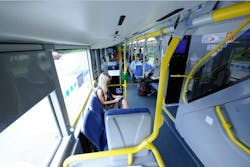The “Ah ha!” Moment: Using Video and Vehicle Metadata to Get to the Evidence You Need
One of the primary benefits of equipping your transit fleet with video surveillance is the ability to use recorded video to help solve problems. Video helps facilitate that ‘ah-ha’ moment, when a security or risk management officer finds the evidence they’re looking for, and the answer to the questions they’ve been trying to answer.
In the transportation industry, the answers — or evidence — can sometimes lead to the possibility of a substantial liability claim payout. Was this bus driver speeding? Did this passenger slip and fall as a result of our infrastructure? Video eliminates the guesswork surrounding these types of investigations and supplies the evidence needed to clearly understand what’s happened and who may be responsible.
Years ago, finding video evidence in these scenarios meant manually pulling hard drives from a bus’s video recorder and then watching hours of footage to pinpoint the exact time of the incident. This could take hours, or even weeks, depending on the number of buses and bus routes in your organization’s fleet.
These days, finding video evidence can take just seconds, provided you have the right technology tools in place.
Video management software that integrates vehicle metadata, such as vehicle speed, location, braking habits and other information, lets you narrow your search very quickly to find what you’re looking for. When used with mobile video recorders that support automated video and data extraction over Wi-Fi, this type of software can provide a complete visual overview of your entire transportation network, enabling you to quickly call up video evidence from any bus based on just a few basic search parameters.
Let’s look at some real life examples where this investigative tool could be used:
Example 1 — Speeding Buses?
Your operations team has received complaints about buses speeding along a particular residential street with a 30 mph speed limit. Several buses travel through this area, so you need to determine which ones, if any, were speeding.
Because your video management software uses interactive maps that work with the GPS modules on your buses, your investigator can draw a geofence (a virtual geographic boundary) around the street where the complaints originated, and then search for speeds over 30 mph. By including a time period — beginning with the time the first bus arrives on the street to the last bus — your investigator can capture information on all buses traveling on that street. If multiple results are returned, video from all buses can be scheduled to download in one single step the next time those buses enter a wireless hotspot.
Example 2 — Whiplash Allegation
A passenger claims that they were injured when the bus they were traveling on slammed on its brakes to avoid hitting a cyclist.
Your team knows the date, time and location of the alleged incident, as well as the vehicle and driver IDs. By entering this information into your video management software, and combining the search with incidents of hard brakes, your investigator can easily determine if the bus in question slammed on its brakes.
This type of search is possible because the bus uses an accelerometer to measure hard stops and aggressive driving. The accelerometer automatically tags video every time vehicle activity is recorded above a certain threshold. A video management system that incorporates this vehicle metadata enables you to search using these ‘tags’ or incidents, and discover what actually happened very quickly. Reviewing the bus’s exterior-facing surveillance cameras at the time in question could also tell you whether a cyclist was in fact in the roadway.
Example 3 — Caught on Camera
A pedestrian was hit by a car yesterday at 1:32 pm at the intersection of Park and Main streets. The accident did not involve a bus, but police have contacted your transportation agency to ask if a bus was in the area at that time and perhaps captured video of the incident.
Your investigative team can answer the question quickly using the video management software. First, they can draw a geofence with a 5-mile radius around the intersection and set the search to fall within the specified timeframe. The search results may show that several buses were in the vicinity of the intersection at the time of the accident, and one in particular was just meters away. By accessing that bus’s forward-facing surveillance camera, you’re able to provide footage of the incident to police to help with the investigation.
In all of these scenarios, the fact that only partial information exists — a location, but no vehicle ID, for example — doesn’t limit the ability of your investigative team to locate the video in question. The powerful combination of surveillance video and integrated vehicle metadata lets you rapidly narrow your search and pinpoint the exact evidence you need in just minutes. In some cases, it could actually eliminate the possibility of costly litigation, saving your organization a substantial amount of money.
This type of tool can also be used to proactively manage your fleet and address issues before they arise, for example with driver training or vehicle malfunctions.
Many transportation agencies already have video surveillance in place, and are also collecting data related to vehicle speed, location, braking and other behaviors. Using video management software to combine these disparate sources of information is a relatively simple step, but one that can significantly improve investigation capabilities and outcomes — providing that ‘Ah ha!’ moment when the answers to questions become clear.
Réal Barrière has more than 15 years’ experience serving the transportation industry with companies including March Networks, Alstom Transport and ISC Applied Systems. He currently oversees product strategy and implementation for March Networks RideSafe intelligent video management solution. [email protected]

Réal Barrière
Réal Barrière has more than 15 years’ experience serving the transportation industry with companies including March Networks, Alstom Transport and ISC Applied Systems. He currently oversees product strategy and implementation for March Networks RideSafe intelligent video management solution.


